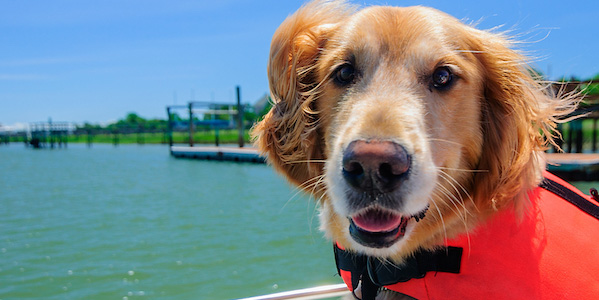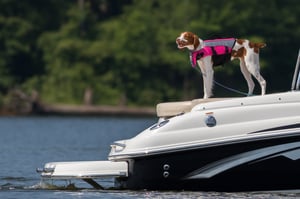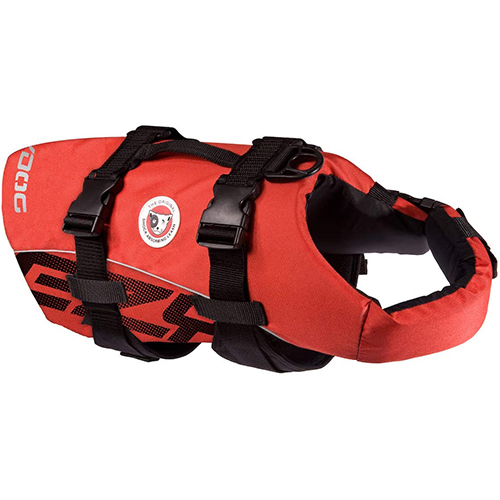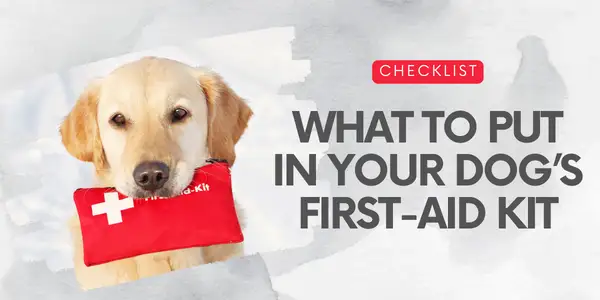 Are you planning on bringing your pup on your next boating adventure? Boating with dogs can be tons of fun for both humans and canines.
Are you planning on bringing your pup on your next boating adventure? Boating with dogs can be tons of fun for both humans and canines.
Take a little bit of time to teach your dog the following three things before going out on the water for a cruise to set everyone up for success.
Practicing well before your first outing on the water will make the start of boating season that much easier and less stressful. By having these training skills in your toolbox, your trip will be safer and more enjoyable for everyone!
And be sure to check out this video featuring Clover the Portuguese Water Dog to see these boating training tips (and helpful dog boating supplies) in action:
How to Teach Your Dog to Get In and Out of Your Boat
If you have a small dog, it's safest and easiest to simply carry them on and off the boat. But for those of you with larger dogs, this isn't really an option! If you can, start with your boat on dry land and steady so your dog first gets used to getting on and off without it rocking.
If you can't dry dock your boat for training, practice on a calm day so there's less rocking to and fro. Depending on the size of your boat and how it is docked, you'll want to practice with the ramp or dog ladder you'll regularly be using while out on the water.
Lure-and-Treat Method
- Hold a yummy dog treat in your closed fist and put that hand out in front of your dog as a target for them to follow. Use this as a lure to encourage your dog to approach the boat and then guide your dog onto the boat. Stay slow and steady so they get used to the new surface under their paws and any movement they might feel.
- Praise them as they follow your lure onto the boat and give them the treat. Then practice going the opposite way, off of the boat and onto the dock (or ground).
- If your dog shows any fear or hesitation, don't force them onto the boat with dragging, pulling, or pushing. Encourage them with praise and consider luring them just one or two steps towards the boat before rewarding them with the treat and allowing them to retreat. Slowly build up more and more steps as they gain confidence and get used to moving closer to and onto the boat.
- Some dogs start off confident and simply need a treat or toy tossed into the boat or back onto the dock to encourage them to move from one place to another. However, it's safest to first show them a few times the correct way on and off so they don't jump awkwardly in their excitement for the treat. They may injure themselves by slipping or falling between the boat and dock.
- As your dog becomes more and more comfortable moving onto the boat, start to add in a verbal cue that tells them it's time to load up. "All aboard!" Say your verbal cue as they get on and off the boat.
With continued practice, your dog will start responding to the verbal cue without your hand lure being needed first. If you do say the verbal cue and they don't respond, simply make the behavior happen with the lure instead of repeating the cue.
- When your dog is successfully loading up and getting off the boat with their verbal cue, you can start to fade out the use of treats to reward the behavior. If you've been practicing on dry land, start to practice this behavior with the boat in calm water and go back a few steps to help your dog keep their balance.
With the slow introduction of more and more movement, your dog will become confident in loading and unloading from the boat in different environments.
- If you have a dog that isn't food motivated but loves playing with toys, you can use one of their favorite toys as the lure and reward once they get on or off the boat. Or consider using a "high value" food treat. Check out this article to learn about the value of different treats for your dog and how best to use treats while training.
How to Teach "Go to Place" on a Boat
Being able to have your dog settle in a specified place while underway helps keeps them safe and prevents distracted boat driving. You don't want your excited pup running about while you're launching your boat or speeding across the water.
Having a designated spot onboard can also help a more nervous dog feel better about riding on a boat. Invest in a comfortable anti-slip mat or pad that's big enough for your dog to lay down on.
This behavior is easiest to start practicing on dry land first, using the same mat you'll be using on the boat. Having a "place" for your dog that you can take with you to different places is a great option! When you go on shore excursions, bring your dog's mat along so they can settle anywhere you go.
For step-by-step instructions on how to teach this to your dog, check out How to Teach Your Dog to Go to Place.This behavior is helpful in so many other situations too, like when guests come to visit or you're opening the door and don't want your dog to bolt out the door.
Watch this video to see how to teach your dog to go to their mat from start to finish combining a technique called shaping with the luring technique:
Practice "Come When Called" While Swimming
Before you allow your dog in the water, you'll want to make sure they are comfortable in the water and know how to swim. Make sure they also have a well-fitted canine life jacket.
A regular come-when-called on dry land is essential before introducing this cue in the water, so make sure you've practiced this behavior around distractions. Watch this video by Kikopup to see how to practice your pup's recall away from distractions:
Using Fetch to Practice Come When Called in the Water
If you have a dog that loves to play fetch, you can use this play drive to build a strong behavior in the water.
- Have two of the same kind of floating water fetch toy for your dog. A bumper like this one from Hyper Pet works well because it's easy for your dog to see in the water (and stands up to lots of chewing). Another alternative is our fetch "stick," which is waterproof, easy on your dog's teeth, floats, and also comes in bright colors that are easy for your dog to see.
- For safety and to help guide your dog back to the boat if needed, use a long lead while you introduce this cue in the water environment. This 30-foot lead is a great option with its bright color and it floats in water.
Safety Note: Just make sure that no other boats are around that might run over your line while your dog is in the water, as serious damages and injuries can happen.
- Practice calling your dog from the same spot on the boat to build consistency with where you want them to swim back to and reload, such as your boat platform or a dog-friendly boat ramp or ladder. This will help in case of emergency if your dog goes overboard as they will have practice returning to the same spot.
- Throw the first toy a short distance from the boat. As your dog retrieves the toy and starts to turn back to the boat, call them to "Come!"
- Encourage and praise them as they swim back to the boat and help guide them back onto the boat from the water if needed.
- Once they're back on board, give them lots of praise and reward them with throwing the second toy for them to fetch.
- You can use treats to reward them for swimming back when they hear the word "come," but often the presence of treats distracts them from the game of fetch and it's hard to get them interested in jumping back in the water once they know you have them.
- Slowly build up the distance you're throwing the fetch toy to build some distance for this cue.
- When you're ready to finish up the game of fetch (keep these games shorter in the water than you would on dry land — swimming is much more tiring than running), reward your dog with a jackpot of treats instead of another toss of the toy when they swim back to the boat.
A jackpot is multiple treats fed one at a time in a row paired with lots of praise and petting.
Now that you've got some useful training skills started, check out this article that has more tips on boating with dogs and find out what supplies you'll need to make sure your dog stays safe and has fun while out on the boat. Happy boating!





